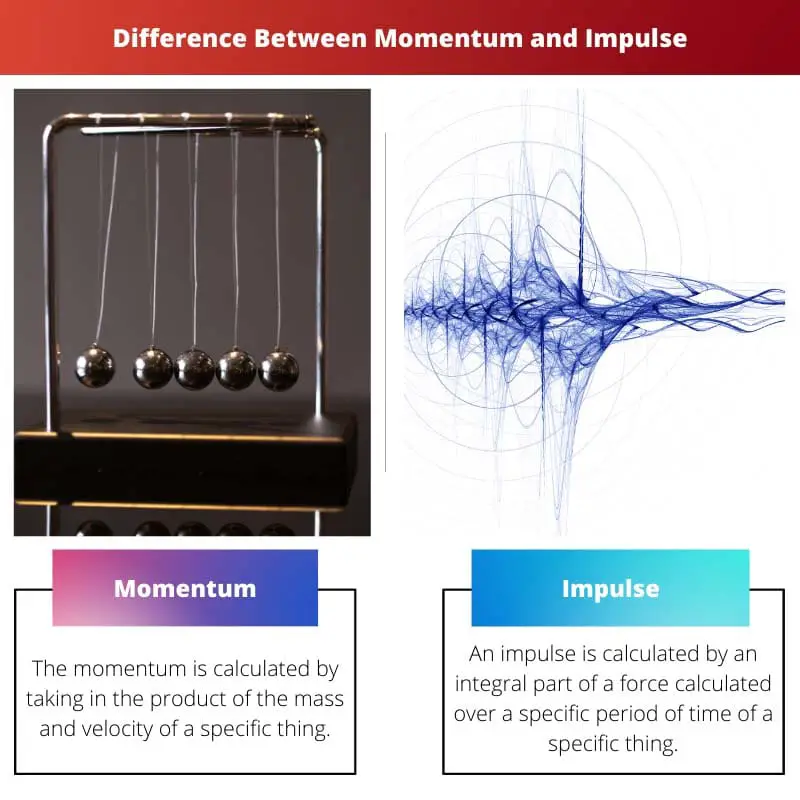Momentum and impulse are two terms derived from the subject of physics. Many people face confusion with the fact that both these terms have the same meaning.
Key Takeaways
- Momentum and impulse are two important concepts in Physics used to describe objects’ motion.
- Momentum is the product of an object’s mass and velocity, while the impulse is an object’s momentum change over a given time.
- Momentum is a vector quantity that remains constant in an isolated system, while the impulse is a scalar quantity that can be applied to an object in any direction.
Momentum vs Impulse
Momentum is calculated by taking in the product of the mass and velocity of a specific thing. On the other hand, the impulse is calculated by an integral part of a force which is calculated over a specific period of a particular item.

Momentum is a term derived from classical mechanics, which comes under the subject of physics. The momentum formula is mass into velocity (p=mv) p stands for momentum, m stands for mass, and v stands for velocity.
Kg. m/s is the SI unit of momentum. If one defines momentum deeply, there is a lot of depth and profound science.
Impulse is a term derived from classical mechanics, which comes under the subject of physics. The formula of impulse is (∆p=F∆t), where ∆p stands for change in momentum, F stands for applied force, and ∆t stands for elapsed time. Newton’s second (N.s) is the DI unit of impulse.
Comparison Table
| Parameters of Comparison | Momentum | Impulse |
|---|---|---|
| Definition | The momentum is calculated by taking in the product of the mass and velocity of a specific thing. | An impulse is calculated by an integral part of a force calculated over a specific period of a particular thing. |
| Use | The momentum formula is used to calculate the force which makes the act. | A formula of impulse is used to calculate when the force is required. |
| Formula | The momentum formula is mass into velocity (p=mv) p stands for momentum, m stands for mass, and v stands for velocity. | The formula of impulse is ∆p=F∆t, where ∆p stands for change in momentum, F stands for applied force, and ∆t stands for elapsed time. |
| SI unit | (Kg. m/s) kilogram per meter second is the SI unit of Momentum. | Newton’s second (N.s) is the SI unit of impulse. |
| Application | Momentum only considers the constant effects of the force acting on the system. | While calculating impulse, the effect of the force acting upon the system and the time it takes for which it works are both considered. |
What is Momentum?
Momentum is a term derived from classical mechanics, which comes under the subject of physics. The momentum formula is mass into velocity (p=mv) p stands for momentum, m stands for mass, and v stands for velocity. (Kg. m/s) kilogram per meter second is the SI unit of momentum.
Kinetic momentum is the primary and general form of momentum. Momentum is vital in calculating the instances related to Newton’s second law.
This is possible because the force exerted is equal to the change in the momentum observed in that particular situation.
Suppose there is more than one system to be calculated in momentum. In that case, one can calculate the momentum of these by calculating the momentum of the individual system of that particle and then adding all of them together as vectors.

What is Impulse?
Impulse is a term derived from classical mechanics, which comes under the subject of physics. The formula of impulse is ∆p=F∆t, where ∆p stands for change in momentum, F stands for applied force, and ∆t stands for elapsed time.
Newton’s second (N.s) is the DI unit of impulse. The study of impulse goes deep down in science.
For the calculation of impulse, the value of the force is required. Another way of representing impulse is the change bought in the momentum of a body or group of bodies.
This method is used globally in the stream of physics. The actual meaning of impulse is a change In movement caused by something due to which something happened. However, there is a vast explanation of impulse under scientific terms.

Main Differences Between Momentum and Impulse
- The momentum is calculated by taking in the product of the mass and velocity of a specific thing. On the other hand, an impulse is calculated by an integral part of a force calculated over a specific period of a particular item.
- The momentum formula is used to calculate the force which does the act, and on the other hand, a procedure of impulse is used to calculate when the force is required.
- The momentum formula is mass into velocity (p=mv) p stands for momentum, m stands for mass, and v stands for velocity. On the other hand, the formula of impulse is ∆p=F∆t, where ∆p stands for change in momentum, F stands for applied force, and ∆t stands for elapsed time.
- (Kg. m/s) kilogram per meter second is the SI unit of Momentum; on the other hand, Newton’s second (N.s) is the SI unit of impulse.
- Momentum considers only the constant effects of the force acting on the system. On the other hand, While calculating impulse, the effect of the force acting upon the system and the time taken for which it acts are both considered.





